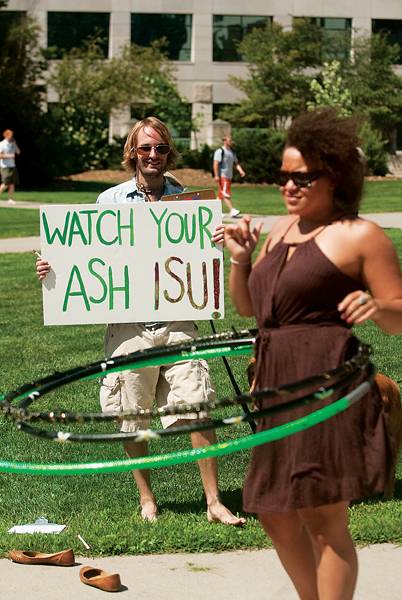Students protest ISU coal plant, engineer says facility is efficient

Celia Jackson, an ActivUs member, hoola-hoops while Aaron Ostrem, an ISU graduate, shows protests coal ash in the background. Jackson and Ostrem were part of a protest in front of Parks Library opposing the release of fly ash into local groundwater. Photo: Tim Reuter/ Iowa State Daily
August 24, 2009
Walking by the Parks Library Monday afternoon, students were greeted with tents and signs welcoming them back to campus. But on the lawn across from the Hub, students were greeted by another message:
“Watch your ash, ISU!”
The slogan was part of a demonstration by the student environmental group ActivUs. The demonstration, made up of several students, a golden retriever and some painted signs, protested the ash disposal practices of Iowa State’s coal power plant. The group plans to continue a campaign directed at the coal plant.
ActivUs, formerly known as Students for Iowa PIRG, wants to raise awareness about fly ash, a residual product of coal combustion. Fly ash can contain radioactive elements such as uranium and thorium, as well as arsenic, boron, mercury and lead. The group took issue with the method of disposal used by the ISU power plant.
Currently, the fly ash is sent to the Basic Materials quarry in Waterloo, said Lindsey Wanderscheid, plant engineer at the coal plant. The potential problem lies in the fact that it is an unlined quarry. There are no federal standards pertaining to fly ash disposal, which allows states to regulate as they see fit. ActivUs member Graham Jordison, senior in political science, worries that this method of disposal could lead to contamination of the water supply. Cases of fly ash water contamination have been documented in Indiana, Maryland, Montana, Wisconsin and Virginia, according to an article in the Iowa Independent.
However, the risk of fly ash contamination varies by location. The make-up of fly ash can differ, and the environmental factors of an area play a large part in the risk for contamination, according to the article.
Jeff Witt, assistant director of utilities with facilities planning and management, could not be reached for comment on Monday.
“The boiler ash … is used for beneficial uses in accordance with Chapter 108 of the Iowa Administrative Code,” Wanderscheid said. “Chapter 108 was developed to establish rules for determining when a solid by-product is a resource … The purpose of the chapter is to encourage utilization of these by-products as resources when possible.”
Iowa’s three regent institutions abide by these practices, periodically performing an analysis of the ash products that is shared with Basic Materials and the Iowa Department of Natural Resources, Wanderscheid said.
Waterloo’s Basic Materials quarry is one of four ash disposal sites in Iowa that received a beneficial use waiver from the department of natural resources, which means that these sites are not subject to the environmental regulations that apply to Iowa’s 12 other disposal sites, according to the article. In addition, the beneficial use waiver does not require sites to monitor the water supply to determine whether it is being contaminated with elements from fly ash.
The proposed benefit of “beneficial use” is low-cost ash disposal, which is being taken advantage of by more than just Iowa’s regent universities — Iowa imports fly ash from Illinois, Indiana and Wisconsin.
Disposal methods aside, ISU’s power plant attains efficiency levels of 55 percent — about 10 percent higher than a typical utility plant, Wanderscheid said. The plant reduces coal burn and ash production by cogenerating, a process that simultaneously produces thermal energy for heating and cooling as well as electric power. Coal burn is reduced by 15,000 tons per year, and ash production is reduced by 2,600 tons per year.
Jordison expressed concern that Iowa State’s “Live Green” campaign is not taking students’ health and safety into consideration because of the risks posed by beneficial use disposal of fly ash.
“Our number one commitment is students’ public health and safety through environmental justice,” Jordison said.
The EPA has said it will draft federal regulations pertaining to ash disposal by the end of 2009.
“There is some speculation that liners and groundwater monitoring will be required,” Wanderscheid said. “If that is the case, Basic Materials and other similar facilities will need to modify their facility to comply with the new requirements.”






